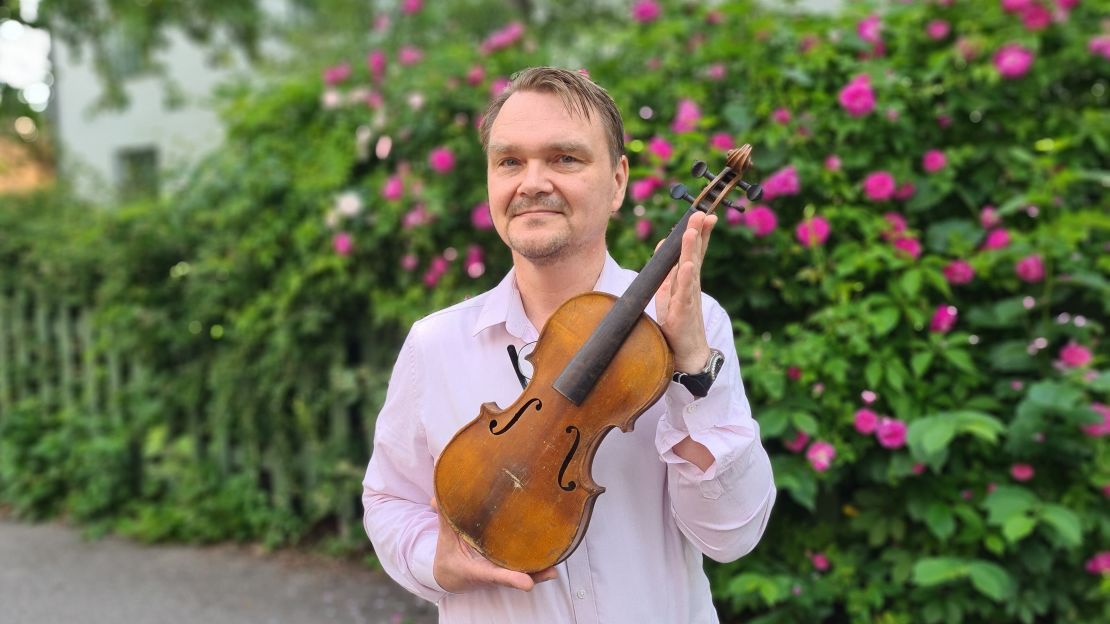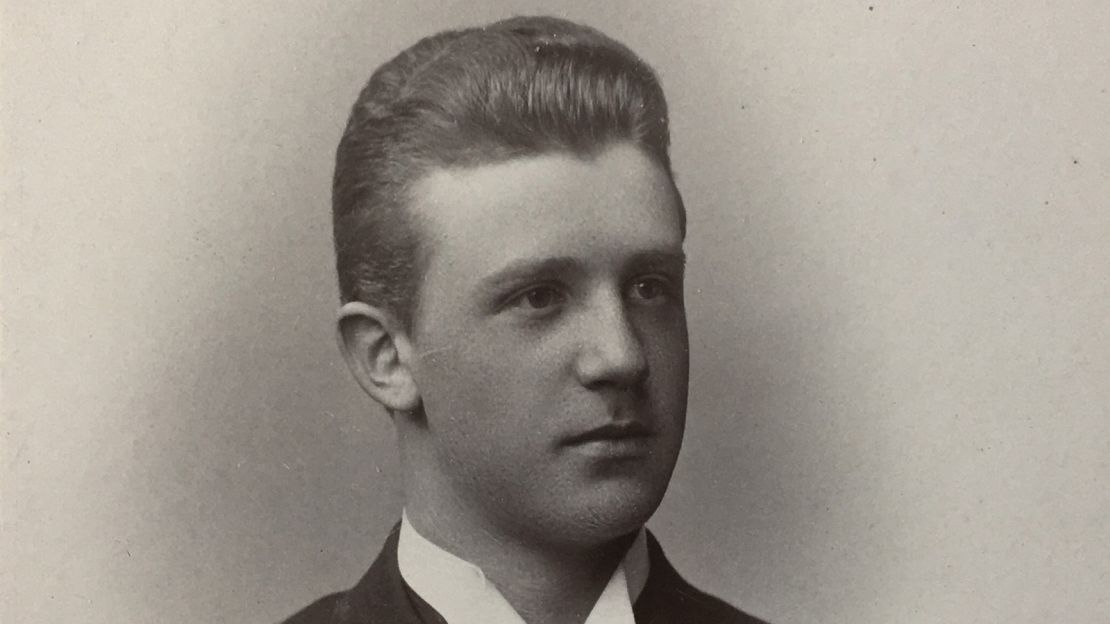Hans Öqvist was a twenty-something university graduate living in Uppsala, Sweden. It was the mid-1990s, and Öqvist spent his weekends roaming the city’s cobbled streets, dipping into thrift shops to look for odds and ends to fill the flat he’d just moved into with his then-girlfriend.
Rummaging through a store one day, Öqvist stumbled across a battered old violin.
Öqvist was a music lover who’d played violin for several years, but had fallen out of practice during his compulsory military service in Sweden. Part of an Arctic regiment, the thought of bare fingers in glacial temperatures had been unappealing.
Öqvist inspected the thrift store violin.
“It had gone through some hard times, the neck was loose, the strings were gone and no bow was in the case,” he tells CNN Travel today.
Despite the violin’s sorry state, Öqvist felt inspired – he could fix the instrument up, breathe new life into it, and start playing again.
Purchasing the instrument for 50 kronor (around $5 USD) Öqvist took it home and examined it more closely.
It was quickly obvious that the violin was too far gone for an amateur to repair it, not without some professional help.
But Öqvist’s eye was drawn to words etched into the wood, what looked like a name – “Hakon Lundström” – followed by a year – “1881.”
Underneath were three lines of Russian Cyrillic characters.
Intrigued, Öqvist spent the next few days trying to translate these etchings – but he struggled to make progress.
“I really couldn’t get that far, so I just put the violin in the closet and thought, ‘Well, someday, I’ll get to the bottom of this mystery,’” says Öqvist today. “But, you know, things that you put away, they stay hidden away until you find some reason to take care of them.”
A mystery uncovered

Fast forward 20 odd years to the present day and Öqvist is still living in Uppsala, now with his wife, Annette, and their three sons.
Busy with his family and career, the mystery of the violin was driven to the back of Öqvist’s mind.
“All the while the old violin followed along listening to the noise of life from its hiding place in the closet,” he says.
One day in early 2021, one of Öqvist’s sons told his parents he had the opportunity to learn an instrument at school, and that he was leaning towards the violin.
As Öqvist started browsing the internet for a good deal on a starter instrument, his mind turned to the thrift store violin he’d purchased all those years previously.
Öqvist fished it out the closet, blew off the cobwebs and examined it anew. While 20 years ago he’d only had reference books to help him along the way, now Öqvist had a cellphone with a high resolution camera, and access to the internet.
“So I made a renewed effort to find out what was written, and spent an evening trying to photograph these inscriptions,” Öqvist says.
He posted the resulting images to a subreddit devoted to the Russian language.
Commentators explaining that the characters spelled out a name – “Hakon Karlsson Lundström” – the same name written in Swedish elsewhere on the instrument – and a location – “St Peter.”
With a name, date and now a city – St. Petersburg – confirmed, Öqvist started researching Hakon Lundström.
Slightly to his disappointment, he discovered Lundström hadn’t been a famous violinist.
However he had been a prominent Swedish journalist in the early 20th century, and had lived in Russia, as a boy.
While Googling, Öqvist also came across a musical arrangement attributed to Lundström, set to a poem by famous Swedish playwright August Strindberg.
The arrangement was on the website of a man called Jan Alm, a professional music arranger who also played double bass in the Gothenburg Symphony Orchestra.
Öqvist dropped Alm a message, telling him about the violin and his quest to learn more about its owner.
Alm responded explaining that he’d produced the arrangement on behalf of a woman named Ulrika Nielsen.
Family connection

One of Ulrika Nielsen’s fondest memories is a special moment shared with her grandmother as a small child.
“We went down to the beach and sat there on a bench, and then she sang this song for me with words written by August Strindberg, Swedish author, and a melody made by her father,” Nielsen tells CNN Travel today.
When her grandmother died in 2008, Nielsen wanted to pay tribute to her by singing the song. The significance seemed apt, epitomizing how people live on through family memories.
“I bear it with me wherever I go,” says Nielsen of the song.
The melody had never been written down, and Nielsen only knew the tune via her grandmother, so she contacted her musician friend Jan Alm and asked if he’d arrange the song in three parts.
He did, and Nielsen and her brother and sister sang it at their grandmother’s memorial.
It was 13 years later when Hans Öqvist reached out to Alm, who forwarded the message to Nielsen.
Surprised and intrigued, Nielsen forwarded the message on to her father, Bernt Nielsen.
“Is this right?” She asked him, “Do you think this violin belonged to your grandfather?”
Bernt, a retiree living in the Swedish city of Gothenburg, scanned through the email, which included the details of Hakon Lundström’s life that Öqvist had managed to piece together so far.
“That’s him,” thought Bernt.
He sent Öqvist a response, introducing himself and confirming the connection.
Unlikely connection

So began a chance correspondence-turned-friendship between two men on opposite sides of the country. Writing from coastal Gothenberg, Bernt Nielsen shared what he knew of the grandfather who’d died before he was born, while in Upsalla, Hans Öqvist told the story of stumbling across the violin at a thrift store all those years previously.
It was the midst of the Covid-19 pandemic, and both men enjoyed dwelling not on the difficulties of the present, but on the past, and its myriad of memories, mysteries and coincidences.
Bernt told Öqvist that as well as living in St. Petersburg, Hakon Lundström had also spent time in Finland. He’d studied at Uppsala University.
Öqvist has shown the violin to a violin maker, who explained it was one of many such instruments produced out of Germany in the late 19th century.
Bernt doesn’t know how the violin ended up in the thrift store in Uppsala – he guesses the instrument must have had other owners in the intervening years, especially given how worn it is. He imagines that his grandfather upgraded it for a larger one as a young man.
“My mother adored her father and often talked about him,” says Bernt. “She also told us how proud she was when father and daughter played the violin and piano together. In late years he found peace and happiness when reading and playing the violin.”
Bernt told Öqvist that many of his family members were musical – Ulrika Nielsen, of course, was a singer, and Bernt had a young grandson who’d just started learning the violin.
For Öqvist, that sealed the deal – he knew he had to return the instrument to the Nielsen family.
When the pandemic situation in Sweden allows, Bernt and Öqvist plan to meet and exchange the instrument, which the Nielsen family will then restore to its former glory.
For Ulrika Nielsen, the experience has shone new light on the family stories of her beloved grandmother, and allowed her to reflect on the importance of music in her life, even as Covid restrictions prevent her from performing as she normally would.
“Not being able to sing since March last year has been a really trying time,” she says. “But then this story came as the sun shining suddenly.”
For Öqvist, connecting with Bernt and Ulrika is the happy end to a mystery he’d long ago written off as unknowable.
And for Bernt, it’s a full circle moment that’s brought unexpected joy – both a reunion with a family heirloom, and the birth of a new friendship.
“This story comes close to the heart,” he says.
“When my grandfather first […] played the violin, he wouldn’t have thought this will make it possible for two people in Sweden in 140 years to meet.”




![<strong>Power of coincidence:</strong> Lundström's grandson is really excited to meet Hans Öqvist and share stories of Lundström, who is pictured here as an older man. "When my grandfather first [...] played the violin, he wouldn't have thought this will make it possible for two people in Sweden in 140 years to meet," Bernt Nielsen tells CNN Travel.](https://media.cnn.com/api/v1/images/stellar/prod/210716123158-hakon-w-l.jpg?q=w_1600,h_900,x_0,y_0,c_fill/h_447)